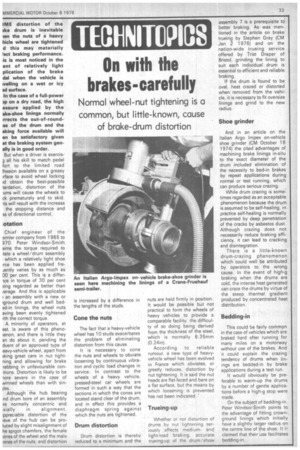On with the brakes-carefully
Page 35

If you've noticed an error in this article please click here to report it so we can fix it.
Normal wheel-nut tightening is a common, but little-known, cause of brake-drum distortion
ME distortion of the Ike drum is inevitable len the nuts of a heavy hide wheel are tightened d this may materially feet braking performance. is is most noticed in the ent of relatively light plication of the brake dal when the vehicle is iveiling on a wet or icy ad surface.
In the case of a full-power lp on a dry road, the high essure applied by the ake-shoe linings normally Irrects the out-of-roundIss of the drum and the aking force available will en be satisfactory given at the braking system genally is in good order.
But when a driver is exercisg all his skill to match pedal fort to the limited road lhesion available on a greasy Irface to avoid wheel locking id obtain the best-possible tardation, distortion of the urns will cause the wheels to ck prematurely and to skid. 'is will result with the increase the stopping distance and ss of directional control.
otation
Chief engineer of the aimler company from 1965 to 970. Peter Windsor-Smith aims the torque required to late a wheel /drum assembly
which a relatively light shoe ,rce has been applied freJently varies by as much as DO per cent. This is a differIce in torque of 30 per cent aing regarded as better than ierage. And this is applicable
an assembly with a new or iground drum and well beded-in linings, the wheel nuts aving been evenly tightened iith the correct torque.
A minority of operators, at est, is aware of this phenolenon, and there is little they 3n do about it, pending the dvent of an approved type of eavy-vehicle wheel, apart from 3king great care in nut tightning and allowing for brake rabbing in unfavourable conitions. Distortion is likely to be lore severe in the case of irvinned wheels than with sinks.
Although the hub bearing nd drum bore of an assembly re normally concentric and
ixially in alignment, ippreciable distortion of the lave of the hub can be proluced by slight misalignment of he spigot chamfers, the female :ones of the wheel and the male :ones of the nuts; and distortion is increased by a difference in the lengths of the studs
Cone the nuts
The fact that a heavy-vehicle wheel has 10 studs exacerbates the problem of eliminating distortion from this cause.
It is necessary to cone the nuts and wheels to obviate loosening by continuous vibration and cyclic load changes in service. In contrast to the wheels of a heavy vehicle, pressed-steel car wheels are formed in such a way that the sections in which the cones are located stand clear of the drum, and in effect this provides. a diaphragm spring against which the nuts are tightened.
Drum distortion
Drum distortion is thereby reduced to a minimum and the nuts are held firmly in position. It would be possible but not practical to form the wheels of heavy vehicles to provide a comparable facility, the difficulty of so doing being derived from the thickness of the steel, which is normally 6.35mm (0.24in) According to reliable rumour, a new type of heavyvehicle wheel has been evolved in France which obviates, or greatly reduces, distortion by nut tightening. It is said the nut heads are flat-faced and bare on a flat surface, but the means by which loosening is prevented has not been indicated.
Trueing-up
Whether or not distortion of drums by nut tightening seriously affects mediumand light-load braking. accurate trueing-up of the drum /show
assembly 7 is a prerequisite to better braking. As was mentioned in the article on brake trueing by Stephen Gray (CM Jan 2 1976) and on the nation-wide trueing service offered by Trist Draper of Bristol, grinding the lining to suit each individual drum is essential to efficient and reliable braking.
If the drum is found to be oval, heat crazed or distorted when removed from the vehicle, it is necessary to fit oversize linings and grind to the new radius.
Shoe grinder
And in an article on the Italian Argo Impex on-vehicle shoe grinder (CM October 18 1974) the cited advantages of machining brake linings in-situ to the exact diameter of the drum included elimination of the necessity to bed-in brakes by repeat applications during normal or test running, which can produce serious crazing.
While drum crazing is sometimes regarded as an acceptable phenomenon because the drum is assumed to be self-healing, in practice self-healing is normally prevented by deep penetration of the cracks by asbestos dust. Although crazing does not necessarily reduce braking efficiency, it can lead to cracking and disintegration.
There is a little-known drum-crazing phenomenon which could well be attributed by operators to the wrong cause. In the event of high-g braking when the drums are cold, the intense heat generated can craze the drums by virtue of the steep. thermal gradient produced by concentrated heat distribution.
Bedding-in
This could be fairly common in the case of vehicles which are braked hard after running for many miles on a motorway without use of the brakes. And it could explain the crazing tendency of drums when linings are bedded-in by brake applications during a test run.
It would obviously be preferable to warm-up the drums by a number of gentle applications before a high-g stop were made.
On the subject of bedding-in, Peter Windsor-Smith points to the advantage of fitting crownground linings which initially have a slightly larger radius on the centre line of the shoe. It claimed that their use facilitates bedding-in.




















































































